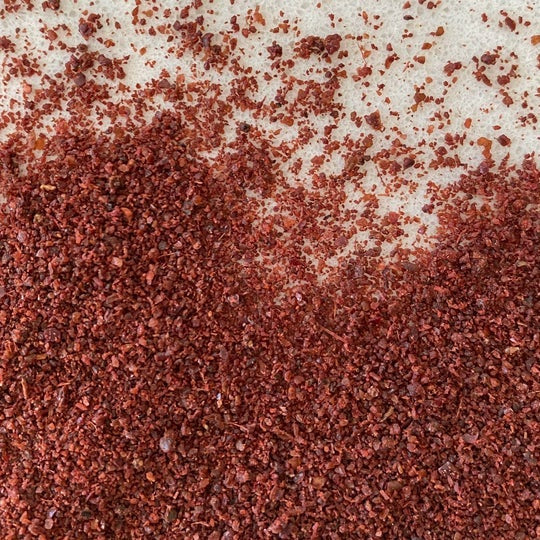Sumac is the ground red berries of the Sumac plant. The spice is celebrated for its earthy, acidic flavor and ruby color.
Native + Cultivated
Sumac is native to the Mediterranean and the Middle East. The plant, a bush that can reach heights of 30 ft, grows wild from Italy to Lebanon and is cultivated throughout Asia, Africa, and North America.

Jerry Hopman / Getty Images
Flavor, Substitutes + Uses
There are numerous varieties of sumac, each with their own flavor and pigment profiles. The berry hue will change depending on the season, soil composition and varietal. Similarly, the taste of sumac is subject to environment influences and personal interpretation. Descriptions range from sour to floral. Lemon and vinegar are often used as substitutes, but both are far more acid than the spice. Paprika may be used as a color substitute in dishes, but its base hue is orange while Sumac has a red or purple undertone.
Whole sumac berries can be purchased throughout the Middle East and Mediterranean, and the berries are usually ground for use. Ground sumac is a key ingredient to Za’atar blends, fantastic on seafood, traditionally used in seasoned rice and a fun addition to fruit salads. Here are a few of our favorite recipes featuring sumac.
Roasted Butternut Squash and Red Onion with Tahini and Israeli Za'atar
Sumac Seared Scallops with Mostarda
Lebanese Fattoush Salad
Additives + Poison Sumac
Spice merchants will occasionally use natural additives to standardize the color and grain of ground sumac. Beet juice may be used to align softer hued ground sumac with the rich pigment consumers associate with the spice. Salt may be added to assist in moisture control and mitigate clumping. When purchasing ground sumac, look for additive and salt free options.
In our shops customers often ask if Sumac is poisonous. There are plenty of wild Sumac varietals growing in North America and none are sold for consumption. While most of these are inedible, they are nontoxic. The exception is Poison Sumac (Toxicodenron vernix). It causes skin swelling and pustule eruptions similar to poison ivy and poison oak. Touching the plant or inhaling smoke from burnt poison sumac can result in serious and sometimes life-threatening symptoms.
References:
What is Sumac? Learn How to Use Sumac with Tips and 8 Sumac Recipes by the Masterclass Staff
The Spice Companion: A Guide to The World of Spices by Lior Lev Sercarz








